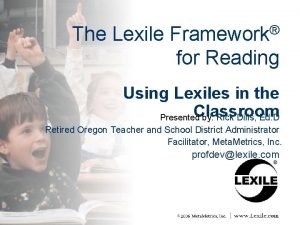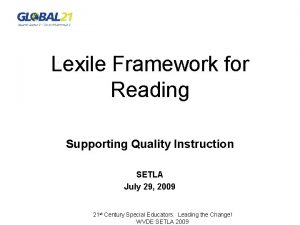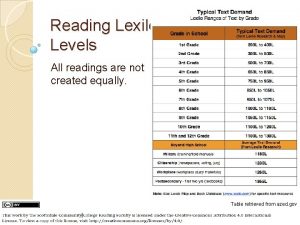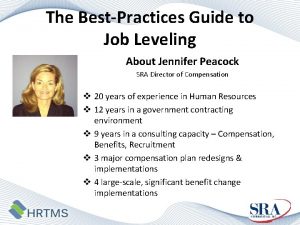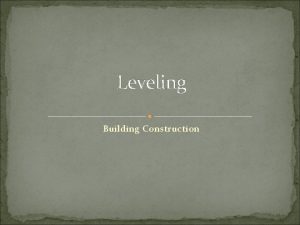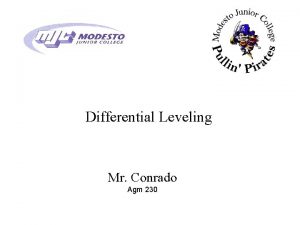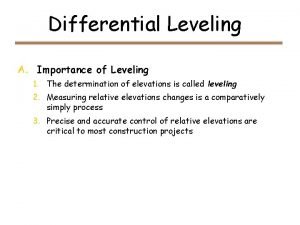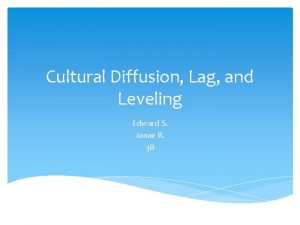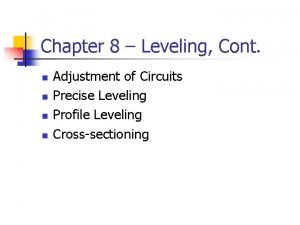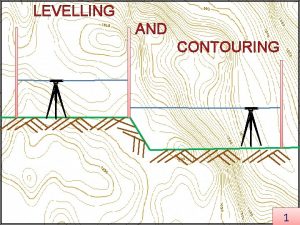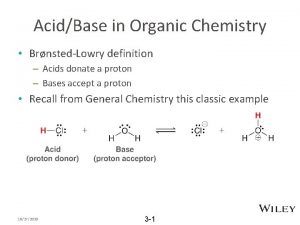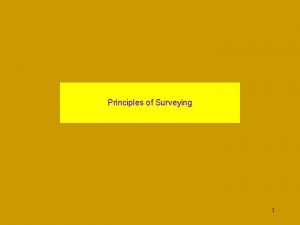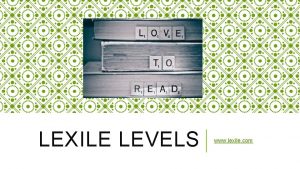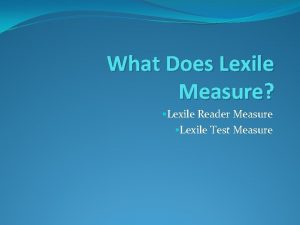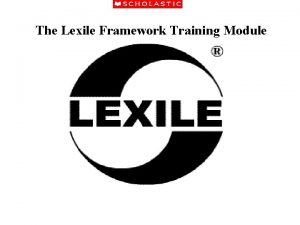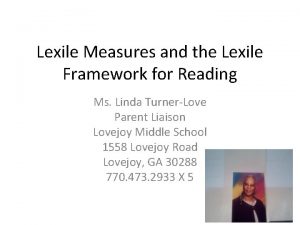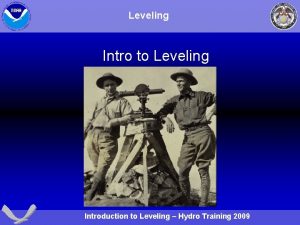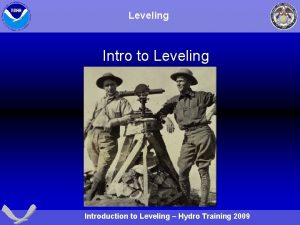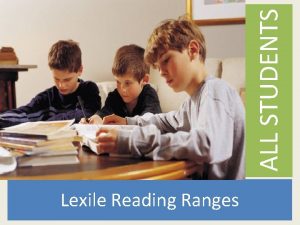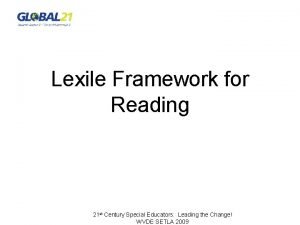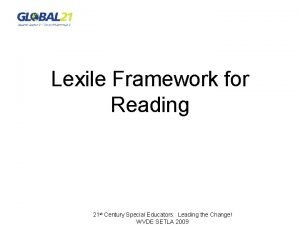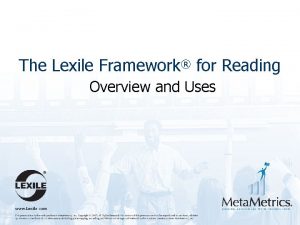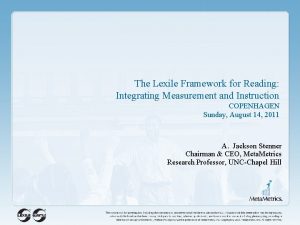The Lexile Framework for Reading Text Leveling in


























- Slides: 26

The Lexile Framework® for Reading Text Leveling in the Ed Group


What Is a Lexile? A Lexile is a unit of measurement.

The Lexile Framework® for Reading • The Lexile Framework for Reading is a scientific approach to reading measurement that matches readers to text. Lexiles measure both reader ability and text difficulty on the same scale. Lexiles allow educators to measure reading comprehension.

The Lexile is a Readability Formula • Readability formula are determined by a theory on written language and the use of mathematical equations to calculate text difficulty. • Lexile measures are determined by: – – Syntactic complexity (sentence length) Semantic variability (word frequency)

The Theory and The Practice TEXT DEMAND – – The Lexile Analyzer, operated by Meta. Metrics, provides a LEXILE score for texts. The Lexile Analyzer measure word frequency and sentence complexity to create a score for the texts. READER ABILITY – The SRI, developed by Scholastic in conjunction with Meta. Metrics, generates a NATIVE LEXILE SCORE for students. The Lexile Analyzer + SRI = the Lexile Framework

The Theory and Practice Reading Independently Reading Instructionally

Forecasting Reading Comprehension Rates Reader Ability Forecasted Comprehension Rates Text Demand 9

Expected Growth for the Average Student

National Norms

The Lexile Framework The Most Widely Used and Respected Common Scale to Measure Comprehension ü Developed by Meta. Metrics, Inc. ü Scientifically created readability formula for leveling texts and understanding text demand ü Built on a corpus of more than 100, 000 books and 80 million articles ü Measures 28 million students annually ü Links to 19 high-stakes state and 7 national tests ü Connects assessment to instruction

17.

The Limits of the Lexile Framework • Cannot determine mature content in texts ü • Does not immediately inform Grade level equivalents ü • Measures are mitigated by The Lexile codes are: • AD: Adult Directed • NC: Non-Conforming • HL: High-Low • IG: Illustrated Guide • GN: Graphic Novel • BR: Beginning Reading • NP: Non-Prose Equal interval scale Best measures continuous text ü Poetry, plays, joke books, low word or no word texts that rely on illustration may not receive a useful Lexile measure • Reports reading comprehension skill ü a capstone skill

How Do You Match Students to Books?

SRI and SRC! • Scholastic Reading Inventory measure students’ Lexile level and their Lexile growth. • Scholastic Reading Counts! motivates, monitors, assesses, and holds students accountable for what they read.

Here’s How It Works

Here’s How It Works • Student selects a book • Student reads a book • Student takes a computer-based quiz • Student receives immediate feedback

The Student Experience • As students are enrolled, they are assigned a reading level • They select books and read a book from an interest-based quiz list • As students work with the program, automatic book lists are suggested to them • .

The Student Experience • No two quizzes are the same - a bank of 30 quiz items provides a randomized test • A large bank of quizzes allows for retakes • Special needs addressed with customization settings

The Student Experience • Student participation encouraged! • CONGRATULATION SCREENS celebrate accomplishment • Read-O-Meter encourages students to rate each book they read successfully.

The Student Experience

Welcome to Scholastic Achievement Manager

SRC! Report Types • Management: Provides school and district level view of enrolled students in SAM and all teachers using the program • Instructional Planning: Informs teachers of specific student reading behaviors for targeted, data driven instruction through numerous metrics: Lexile, words read, books read and points • Progress Monitoring: Provides information on student skills progress and their time spent on task, keeping teachers informed on how individual students, classes, or groups perform over time • Alerts & Acknowledgments: Signals teachers to milestones or deficits in their students’ achievements • School-to-Home: Generates Guardian letters in English or Spanish for each student. Provides home involvement suggestions.

Customize Quiz Settings • Quiz attempts allowed: Set the number of times a student can take a quiz. The range is from 1 to 6. The default setting is 3 attempts. • Number of questions per quiz: Set the number of questions in a quiz ranging from 5 to 30. The default number is 10. • Percentage required to pass a quiz: Set the percentage of quiz questions a student must answer correctly to pass a quiz. The range is from 0% to 100%. The default is 70%. • Retake days between quizzes: Set the minimum number of days a student must wait before retaking a quiz. The default number is 1 day. • Allow teachers to enter offline quiz scores: Enables teachers to enter print tests manually. The default setting is on. Users with administrator permissions may turn the setting off, though this prevents teachers from entering any print tests for their students.

Why It Matters! Variation in Amount of Independent Reading (5 th grade) Percentile Independent Reading Minutes per day 98% 65. 0 4, 358, 000 90% 21. 1 1, 832, 000 80% 14. 2 1, 146, 000 70% 9. 6 622, 000 60% 6. 5 432, 000 50% 4. 6 282, 000 40% 3. 2 200, 000 30% 1. 3 106, 000 20% 0. 7 21, 000 10% 0. 1 8, 000 • Anderson, Wilson, Fielding (1998). • Adapted by Cunningham and Stanovich (1998). Words Read per year

Measure Independent Reading Success • Introduce students to great books • Wrap a technology program around their personal reading efforts • Monitor their reading • Report in Lexile actionable data about their reading progress • Demonstrate accountably Only with Scholastic Reading Counts!
 Lexile range by grade
Lexile range by grade Lexile score calculator
Lexile score calculator Text-to-media connection
Text-to-media connection Lexile score
Lexile score 1200-1300 lexile books
1200-1300 lexile books Jag har gått inunder stjärnor text
Jag har gått inunder stjärnor text Pre reading while reading and post reading activities
Pre reading while reading and post reading activities Job leveling matrix
Job leveling matrix How to do a level loop survey
How to do a level loop survey Profile leveling definition
Profile leveling definition Leveling effect organic chemistry
Leveling effect organic chemistry Leveling in construction
Leveling in construction Eccentric leveling lugs
Eccentric leveling lugs Differential leveling example
Differential leveling example What is differential levelling
What is differential levelling Cultural leveling sociology
Cultural leveling sociology Resource allocation vs resource leveling
Resource allocation vs resource leveling Difference between profile levelling and cross sectioning
Difference between profile levelling and cross sectioning Leveling effect organic chemistry
Leveling effect organic chemistry Resource loading chart example
Resource loading chart example Direct method of contouring
Direct method of contouring What is levelling
What is levelling Ario+
Ario+ Resource leveling pmp
Resource leveling pmp Horizontal line
Horizontal line Which of the following is a strategy to promote leveling?
Which of the following is a strategy to promote leveling? Vial datum
Vial datum
